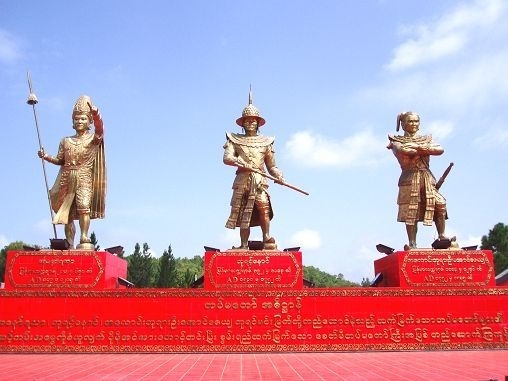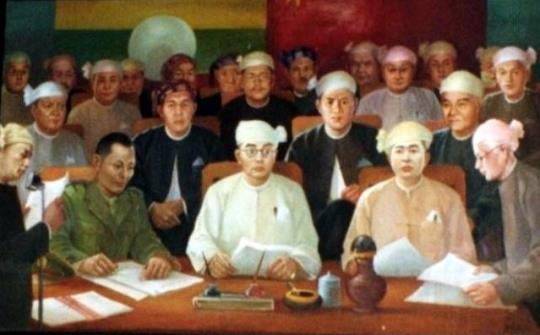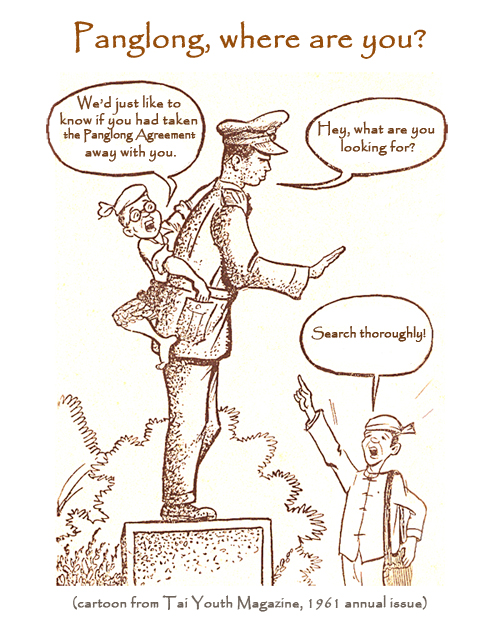History is about facts and who is telling the story.
.
Smallville TV series
According to the first sentence on Page 1 of the 2015 Defense White Paper, “The Republic of the Union of Myanmar” (was) first founded, not in 1948 as is universally accepted, but “by the Bagan dynasty over a thousand years ago.”
Incredible as it may seem, the “proof” is in the statues of the three kings overlooking the parade ground in Naypyitaw. Any ordinary Bamar seeing them may feel proud of being a descendent of such warrior-kings, and that it’s his/her duty to preserve this land no matter what the consequences are. But we can also ask non Bamar visitors especially Shans, Mons and Arakanese, to Naypyitaw. What their feelings are on seeing these awesome figures. The likely answer may be if the Bamars go on revering kings that forcefully occupied our ancestral lands, their descendants have no right to call for our allegiance to them.

On the other hand, the psychological effect on all of them may be different, if there were, say, statues of Aung San and non-Bamar leaders stood together and held the 1947 Panglong Agreement instead.
Because to them, what the three kings, and later the British, had forged were not unions as claimed but empires. Then Aung San and leaders of the Frontier Areas, notably Chin Hills, Kachin Hills, and the Federated Shan States signed an agreement with the aim to establish a union. We should remember, said the late Shan politician Shwe Ohn, hadn’t it been for the Panglong Agreement, we could have been separate countries. However as far as the non-Bamars are concerned, the terms of the agreement, except for one, have not been fulfilled:
- Appointment of Frontier Areas representatives as central government ministers then called counselors which academics term “Shared-rule”. Accordingly, state chief ministers were also union ministers until 1962, but not afterward.
- Full autonomy (meaning with its own laws) which academics term as “self-rule”. But far from being able to have their own constitutions, states were not able to choose their own chief ministers without the consent of the prime minister even during the short lived democratic era.
- Establishing a Kachin State (With Chin Hills, it became a Special Division until 1974 when the status as a state was accorded)
- Human Rights and Democracy
(Tun Myint of Taunggyi, another prominent Shan politician, in his Shan State’s Grievances presentation in 1957, reported bullying, tortures, rapes, Shan girls being sold in cities by TMD soldiers, and providing cash and arms to dissident movements to sow discord. In short, practicing the Divide and Rule policy. “If one compares this kind of behavior to the Japanese excesses, the TMD is clearly enjoying a comfortable lead,” he wrote.
- Financial autonomy (meaning the right to manage its own finances as in the British days plus “Bamar one kyat, Shan one kyat”)

Taxes from extraction of minerals and wood were paid to the Shan States during the British era. It also received percentages of various taxes.
One discovers that the financial relationship between Shan and Burma even during those days was not that between the DONOR and RECIPIENT, but in terms of LIABILITY to pay and to receive. It is unfortunate that after we have become free, we have to use the the word “Subsidy”, discrimination even in terms of terminology, said Tun Myint.
Now about the application of the “Burmese One Kyat, Shan One Kyat” principle. According to the 1952-53 Fiscal Year Budget statistics, calculated by population figures from the 1941 census, one finds that while Mainland Burma got 1 kyat, and the Shan State got only 0.48 kyat.
By the time, U Thein Sein became president in 2011, it became worse. Asia Foundation reported that the 14 states and regions received only 3.6% of the total expenditures. Thereby drawing a comment from a Canadian friend, “Why, Khuensai, you are only 3.6% federal.”
Tun Myint concluded that Shan State bore all the characteristics of a colony: political and legal domination, economic dependence, and exploitation.
The situation was such that there were calls for secession, a right provided by the 1947 constitution. As older, cooler headed leaders opted for political means to resolve the crisis, hot-headed and educated young ones decided to choose the armed struggle in 1958.
65 years have passed since then and the result? Neither the secessionists nor the Unionists are winning Especially the former, whose Mong tai Army, the strongest of all anti-military forces, as conceded even by the MIS, was defeated in 1995, after China decided an independent Shanland was against its interests.
As for the Unionists, they have not fared better either.

However, the Bamar elites had refused to insert the Agreement, let alone discuss it, in the much-vaunted 2015 Nationwide Ceasefire Agreement. The Peace Process that followed it has also steadfastly steered clear of including it in their negotiations, avoiding it as though it were an infectious disease.
After 7 years of negotiations, it has become quite clear nothing significant will be achieved as long as both sides are beating around the bush. And the non-Bamar states, as pointed out by the late Shan politician Tun Myint of Taunggyi in 1957, will continue to be Burmese colonies. Peace will still be an unattainable goal.
It wasn’t like this when we were still under British colonial rule until 75 years ago. The situation was not perfect but we had peace and stability. In the Federated Shan States (as Shan State was known in those days) there were only 2 infantry battalions of the Burma Frontier Force.
On the contrary, today we have a hundred times more battalions in the Shan State alone. And there is no peace. If this situation continues without any glimpse of hope for the people, some suggest perhaps we should ask the British to return and tell us what is going wrong in our country. Why other former colonies like US, India and Malaysia which had suffered under the same “Divide & Rule” British policies are getting ahead while we are still left behind.
The question now is what’s next? Let’s see what fool’s idea I may have about this.
As said earlier, we have fought for Independence but failed. We have also fought for a federal union, still to no avail.
Today the situation is more complex. When I wrote “The Making of a Rebel”, there were only a few tens of thousands of rebels. But now we have hundreds of thousands.
And more options: like elections, reactivation of Daw Suu’s role, diplomacy, supporting non-violent movements, building a golden bridge, as Chinese expert Sun Zi terms it, for the military to retreat across, more sanctions and embargoes, international involvement in peace talks, resetting the media’s role in reshaping society, etc. A mixture of carrots and sticks.
To me, one thing is quite clear. Alone by itself, each of these carrots and sticks won’t work. However, if all or most of them can become parallel lanes of the same road leading in the same direction, there may be hope.
This is not a new idea. The highly respected late Dr. Chao Tzang Yawnghwe, who was both a scholar and armed resistance leader, used to exhort us to apply the principle: Common Goal, Diverse Actions. Like Sun Zi had done earlier with his “qi” (Indirect Approach) and “zheng” (Direct Approach) principles, because one method alone is insufficient to win.
But in order to put it into practice, a competent, dedicated and patient coordination, like Nick Fury did for the Avengers will be necessary. Without people like him, our heroes, however talented they are, would be a long way from winning.
Before I end this article, here’s another fool’s food for thought. Right now, the Three Kings are the present military leaders’ Bible while the Panglong Agreement is the non-Burmans’ Ten Commandments. Until we have a common history text, we may still be living in the same country, but they are worlds apart.
One encouraging fact is that we have not a few historians who follow in the steps of the late Dr. Than Tun, who championed writing history without bias. It will nevertheless take some time. The Oxford Sayadaw Dr. Khammai Dhammasami said it took even experts of the three Buddhist schools 7 years to come up with the Common Buddhist Text.
This means for a common history text, we will need the same growth mindset (in contrast to the fixed mindset). And with the same growth mindset, and a common history text, we can live together happily ever after.



